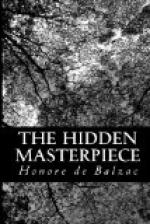Imagine a bald head, the brow full and prominent and falling with deep projection over a little flattened nose turned up at the end like the noses of Rabelais and Socrates; a laughing, wrinkled mouth; a short chin boldly chiselled and garnished with a gray beard cut into a point; sea-green eyes, faded perhaps by age, but whose pupils, contrasting with the pearl-white balls on which they floated, cast at times magnetic glances of anger or enthusiasm. The face in other respects was singularly withered and worn by the weariness of old age, and still more, it would seem, by the action of thoughts which had undermined both soul and body. The eyes had lost their lashes, and the eyebrows were scarcely traced along the projecting arches where they belonged. Imagine such a head upon a lean and feeble body, surround it with lace of dazzling whiteness worked in meshes like a fish-slice, festoon the black velvet doublet of the old man with a heavy gold chain, and you will have a faint idea of the exterior of this strange individual, to whose appearance the dusky light of the landing lent fantastic coloring. You might have thought that a canvas of Rembrandt without its frame had walked silently up the stairway, bringing with it the dark atmosphere which was the sign-manual of the great master. The old man cast a look upon the youth which was full of sagacity; then he rapped three times upon the door, and said, when it was opened by a man in feeble health, apparently about forty years of age, “Good-morning, maitre.”
Porbus bowed respectfully, and made way for his guest, allowing the youth to pass in at the same time, under the impression that he came with the old man, and taking no further notice of him; all the less perhaps because the neophyte stood still beneath the spell which holds a heaven-born painter as he sees for the first time an atelier filled with the materials and instruments of his art. Daylight came from a casement in the roof and fell, focussed as it were, upon a canvas which rested on an easel in the middle of the room, and which bore, as yet, only three or four chalk lines. The light thus concentrated did not reach the dark angles of the vast atelier; but a few wandering reflections gleamed through the russet shadows on the silvered breastplate of a horseman’s cuirass of the fourteenth century as it hung from the wall, or sent sharp lines of light upon the carved and polished cornice of a dresser which held specimens of rare pottery and porcelains, or touched with sparkling points the rough-grained texture of ancient gold-brocaded




